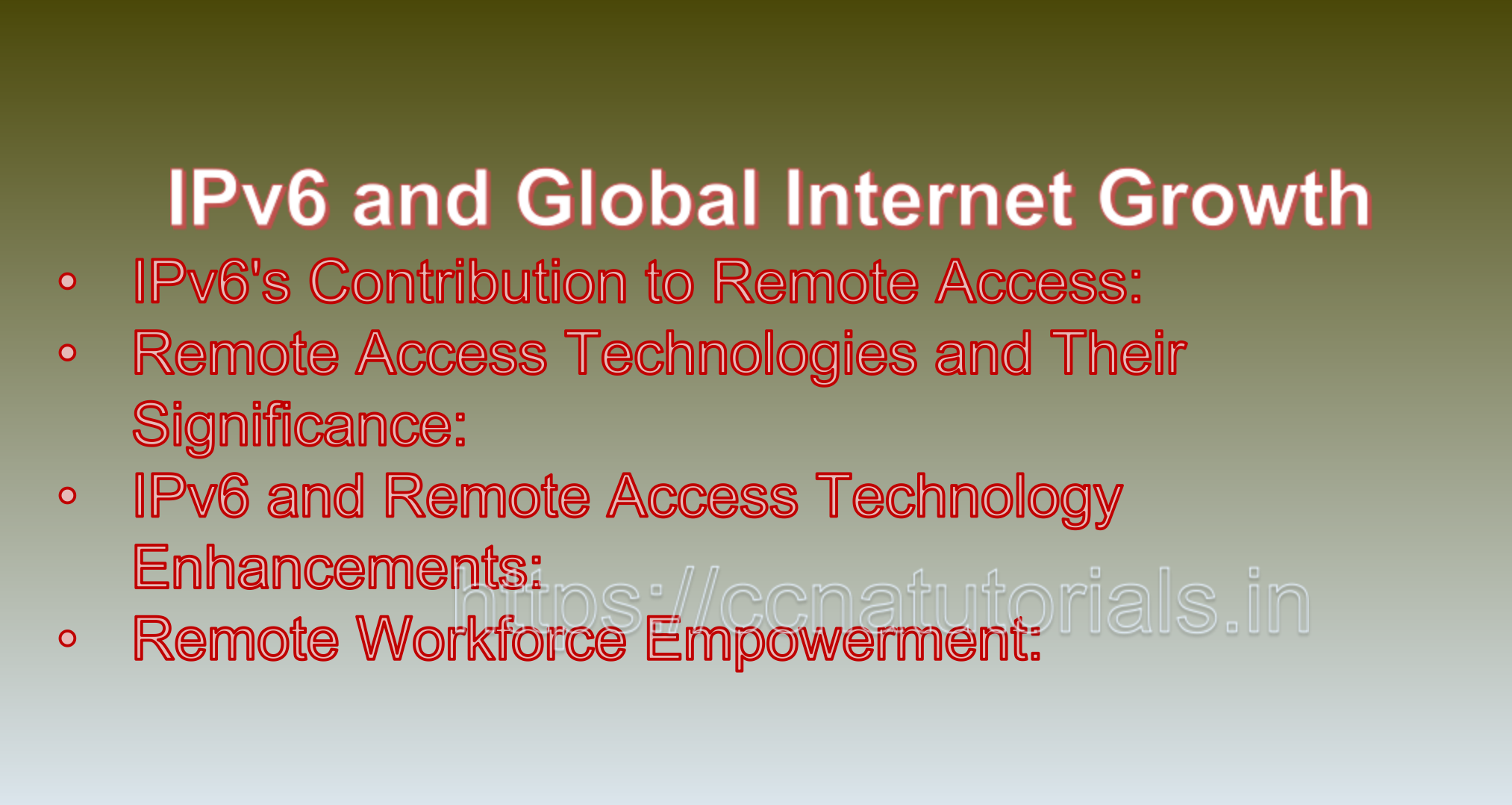Contents of this article
In this article, I describe IPv6 and Remote Access Technologies: Connecting Beyond Boundaries The transition from Internet Protocol version 4 (IPv4) to Internet Protocol version 6 (IPv6) is not just about accommodating the growing number of internet-connected devices but also about enabling seamless connectivity across diverse scenarios, including remote access. Remote access technologies play a crucial role in allowing users to connect to networks and resources from anywhere in the world. With IPv6’s enhanced addressing capabilities and improved routing efficiency, remote access technologies are further empowered to provide secure and efficient connections. This article explores the relationship between IPv6 and remote access technologies, offering examples of how IPv6 enhances remote connectivity.
1. IPv6’s Contribution to Remote Access:
– Address Space:
IPv6’s larger address space enables the allocation of unique addresses to a multitude of devices, including those used for remote access. This ensures that remote devices can be assigned globally routable addresses without the limitations of address exhaustion.
– Efficient Routing:
IPv6’s simplified header structure and improved routing mechanisms contribute to efficient data transmission. This is particularly beneficial for remote access scenarios, where optimized routing reduces latency and enhances the user experience.
2. Remote Access Technologies and Their Significance:
– Virtual Private Networks (VPNs):
VPNs establish secure encrypted tunnels between remote users and the corporate network, ensuring confidential communication over public networks.
– Remote Desktop Services:
Remote desktop technologies allow users to access and control a remote computer as if they were physically present, facilitating remote collaboration and support.
– Secure Shell (SSH):
SSH provides encrypted communication channels for secure remote access to servers and devices, preventing unauthorized access and data breaches.
3. IPv6 and Remote Access Technology Enhancements:
– IPv6 Support in VPNs:
The IPv6 enables VPNs to support both IPv4 and IPv6 traffic, ensuring seamless communication for remote users regardless of the IP protocol they are using.
– IPv6-Enabled Remote Desktop Services:
Remote desktop applications can leverage IPv6 to provide users with direct connectivity to remote systems, simplifying the connection process and enhancing performance.
– Secure IPv6 SSH Connections:
SSH over IPv6 ensures encrypted and secure communication for remote access, extending the benefits of SSH to both IPv4 and IPv6 networks.
4. IPv6 and Remote Access Technology Examples:
– Remote Workforce Empowerment:
– Scenario: A company adopts IPv6 and enhances its remote access infrastructure to support its growing remote workforce.
Outcome:
– Remote workers can connect to the corporate network using IPv6-enabled VPNs, benefiting from efficient routing and secure communication.
– Employees experience reduced latency when accessing resources, leading to improved productivity and user satisfaction.
– The organization’s remote support services utilize IPv6-enabled remote desktop applications, simplifying troubleshooting and enabling efficient problem resolution.
– Secure Server Management:
– Scenario: An IT administrator needs to manage servers remotely while ensuring security.
Outcome:
– The IT administrator establishes secure IPv6 SSH connections to remote servers, protecting sensitive data and preventing unauthorized access.
– IPv6’s enhanced security features ensure the confidentiality and integrity of administrative tasks carried out over the network.
– The use of IPv6-enabled SSH simplifies the process of remotely managing servers in mixed IPv4 and IPv6 environments.
5. IPv6 and Remote Access Implementation Steps:
– Assessment:
Evaluate the remote access technologies currently in use and assess their compatibility with IPv6.
– Vendor Compatibility:
Check whether the remote access solutions and tools you use are IPv6-compatible or require updates.
– Configuration:
Configure your remote access technologies to support IPv6 addresses, protocols, and security mechanisms.
– Testing:
Conduct thorough testing to ensure that remote access over IPv6 functions as expected and provides the desired performance and security.
6. Benefits of IPv6 in Remote Access Scenarios:
– Global Reach:
IPv6’s global addressing enables seamless remote access to resources from anywhere in the world.
– Efficient Communication:
IPv6’s routing enhancements reduce latency and optimize data transmission, enhancing the user experience during remote access.
– Security:
IPv6’s mandatory support for IPsec and other security mechanisms ensures that remote access connections remain encrypted and protected from unauthorized access.

In short IPv6 and Remote Access Technologies Harnessing IPv6 for Seamless Remote Access:
The marriage of IPv6 and remote access technologies represents a powerful alliance that enhances the way individuals and organizations connect to resources and networks from afar. By incorporating IPv6 into remote access solutions, organizations can ensure efficient communication, optimize routing, and enhance security. As the digital landscape continues to evolve and remote work becomes more prevalent, the synergy between IPv6 and remote access technologies paves the way for seamless connectivity across diverse scenarios, ultimately contributing to enhanced productivity, collaboration, and user satisfaction.
IPv6 and Remote Access Technologies: Enabling Secure and Seamless Connectivity
Remote access technologies have become essential in today’s interconnected world, enabling individuals to access resources and services from remote locations. With the transition from Internet Protocol version 4 (IPv4) to Internet Protocol version 6 (IPv6), remote access technologies are undergoing significant enhancements. IPv6 offers benefits such as a larger address space, improved security, and efficient routing, which contribute to more reliable and secure remote connections. This article explores how IPv6 intersects with remote access technologies, providing examples of how organizations and individuals can leverage IPv6 to achieve secure and seamless remote connectivity.
1. IPv6’s Impact on Remote Access:
– Abundant Address Space:
IPv6’s vast address space eliminates address scarcity concerns, ensuring that every device has a unique and globally routable IP address. This facilitates straightforward identification and communication with remote devices.
– Security Enhancements:
IPv6 incorporates security features like IPsec, which provides end-to-end encryption and authentication for remote connections, ensuring data confidentiality and integrity.
– Efficient Routing:
IPv6’s simplified and optimized routing header structure reduces the burden on routers, resulting in efficient routing of remote traffic and improved overall network performance.
2. IPv6 and Remote Access Technologies:
– Virtual Private Networks (VPNs):
IPv6 enables the seamless integration of VPNs, allowing remote users to establish secure connections to corporate networks over IPv6-enabled internet connections.
– Direct Access and Always-On VPNs:
IPv6’s IPsec support enhances the security of always-on VPN connections, ensuring that devices remain secure even when connected remotely.
– Remote Desktop Services:
IPv6 enables efficient communication between remote devices and centralized servers, enhancing the user experience in remote desktop environments.
3. IPv6 Remote Access Solutions:
– Mobile Workforce Connectivity:
– Solution: An organization with a mobile workforce deploys IPv6-enabled VPN solutions to provide employees with secure remote access to internal resources.
– Outcome: Employees can securely access company data and applications using IPv6, regardless of their location, ensuring productivity and data security.
– Remote Support and Troubleshooting:
– Solution: A technology support company adopts IPv6-enabled remote desktop services to provide efficient remote support to clients.
– Outcome: Support technicians can connect to clients’ devices over IPv6, troubleshoot issues, and provide solutions in real time, leading to quicker problem resolution.
4. IPv6 Remote Access Challenges and Considerations:
– Legacy Systems and Compatibility: Some older remote access technologies may not fully support IPv6. Organizations need to evaluate compatibility and consider migration strategies.
– Security Configuration: While IPv6’s IPsec support enhances security, proper configuration and management are crucial to ensure the effectiveness of encrypted remote connections.
5. IPv6 Remote Access Implementation Steps:
– Assessment:
Evaluate your organization’s current remote access infrastructure, identifying areas that can benefit from IPv6 integration.
– Vendor Evaluation:
Research and choose remote access solutions and services that offer IPv6 compatibility and security features.
– Configuration and Testing:
Configure remote access solutions to utilize IPv6 addressing and security mechanisms. Thoroughly test the setup to ensure seamless and secure remote connections.
– Security Measures:
Implement proper security measures, including IPsec configurations, to protect remote connections and data.
6. Benefits of IPv6 in Remote Access:
– Seamless Connectivity:
IPv6’s abundant address space and efficient routing contribute to seamless and reliable remote connections.
– Enhanced Security:
IPv6’s built-in IPsec support ensures encrypted and authenticated remote communication, safeguarding sensitive data.
– Scalability:
IPv6’s large address space accommodates the increasing number of remote devices and users in the growing remote work landscape.
7. IPv6 and Remote Access: Real-World Examples:
– Remote Work Enablement:
– Scenario: A multinational corporation shifts to a remote work model due to global events. The organization adopts IPv6-enabled VPN solutions to provide employees with secure access to internal resources.
Outcome:
– Employees seamlessly connect to the corporate network from various locations using IPv6-enabled VPNs.
– IPv6’s security features, including IPsec, ensure that sensitive data remains protected during remote communication.
– The organization maintains productivity while ensuring data security in a remote work environment.
– Global Remote Collaboration:
– Scenario: A research institution collaborates on projects with international partners. The institution leverages IPv6-enabled remote desktop services to facilitate seamless remote collaboration.
Outcome:
– Researchers from different countries use IPv6 to remotely access shared resources and contribute to projects in real time.
– IPv6’s optimized routing enhances the speed and efficiency of data exchange between remote collaborators.
– The institution experiences improved collaboration and knowledge sharing across geographical boundaries.
Conclusion for IPv6 and Remote Access Technologies Leveraging IPv6 for Secure and Efficient Remote Access:
IPv6’s capabilities bring significant improvements to remote access technologies, addressing the challenges of scalability, security, and efficient communication. By adopting IPv6-enabled remote access solutions, organizations and individuals can establish secure and seamless connections, enabling remote work, collaboration, and support. As remote access continues to play a pivotal role in modern business and communication, embracing IPv6 empowers users with enhanced connectivity and security, ensuring a more productive and connected digital future.






